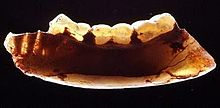Kollikodon
| Kollikodon Temporal range:Cenomanian,
| |
|---|---|

| |
| Opalised jaw ofKollikodon(backlit) | |
| Scientific classification | |
| Domain: | Eukaryota |
| Kingdom: | Animalia |
| Phylum: | Chordata |
| Class: | Mammalia |
| Order: | Monotremata |
| Family: | †Kollikodontidae |
| Genus: | †Kollikodon Flannery, Archer, Rich & Jones, 1995[1] |
| Species: | †K. ritchiei
|
| Binomial name | |
| †Kollikodon ritchiei Flannery, Archer, Rich & Jones, 1995[1]
| |
| Synonyms | |
| |
Kollikodonis an extinct species of mammal, considered to be an earlymonotreme.[2]It is known only from an opaliseddentaryfragment, with onepremolarand twomolarsin situ,as well as a referredmaxillaryfragment containing the last premolar and all four molars. Thefossilswere found in theGriman Creek FormationatLightning Ridge,New South Wales, Australia.Kollikodonlived in theLate Cretaceousperiod, during theCenomanianage (99–96 million years ago). Several other monotremes are known from the Griman Creek Formation, includingDharragarra,Opalios,Parvopalus,Steropodon,andStirtodon.[3]
Etymology
[edit]Kollixis an ancientGreekword (κολλίξ) for a bread roll. The strange teeth ofKollikodon,when seen from above, resemblehot cross buns,traditionally toasted and eaten onGood Friday.Originally, Michael Archer wanted to name it "Hotcrossbunodon", but met disapproval from his associates.[4]
Description
[edit]LikeSteropodon,Kollikodonwas a relatively large mammal for theMesozoic.The molars have a length of around 5.5 mm and a width of between about 4 and 6 mm.[5]Based upon these data, the potential body length could be up to a metre.[6]Assuming the accuracy of such a guess,Kollikodonwould be a contender for the largestMesozoicmammal known, along with other possible giants such asRepenomamus,Schowalteria,andBubodens.
Aside from its size, it is difficult to say whatKollikodonlooked like. It is certain that its teeth were specialised to crush food, being perhaps ashellfish-eater orherbivore.The description of the upper jaw showed that it was strongly specialised, with molars being subdivided into numerous rounded cuspules, some of which exhibit pits, possibly the result of crushing hard items.[7]
In museums
[edit]BothKollikodonandSteropodoncan be found at theAustralian MuseuminSydney,along with Eric, theopalisedpliosaur.
References
[edit]- ^abFlannery, Timothy F.; Archer, Michael; Rich, Thomas H. & Jones, Robert (1995)."A new family of monotremes from the Cretaceous of Australia".Nature.377(6548): 418–420.doi:10.1038/377418a0.S2CID4301982.
- ^Flannery, Timothy F.; Rich, Thomas H.; Vickers-Rich, Patricia; Ziegler, Tim; Veatch, E. Grace; Helgen, Kristofer M. (2022-01-02)."A review of monotreme (Monotremata) evolution".Alcheringa: An Australasian Journal of Palaeontology.46(1): 3–20.doi:10.1080/03115518.2022.2025900.ISSN0311-5518.
- ^Flannery, Timothy F.;McCurry, Matthew R.;Rich, Thomas H.;Vickers-Rich, Patricia;Smith, Elizabeth T.; Helgen, Kristofer M. (2024-05-26)."A diverse assemblage of monotremes (Monotremata) from the Cenomanian Lightning Ridge fauna of New South Wales, Australia".Alcheringa: An Australasian Journal of Palaeontology:1–19.doi:10.1080/03115518.2024.2348753.ISSN0311-5518.
- ^Long, John A.; Archer, Michael; Flannery, Timothy & Hand, Suzanne (2002).Prehistoric mammals of Australia and New Guinea: One hundred million years of evolution.Baltimore, Maryland: Johns Hopkins University Press. p. 39.ISBN978-0801872235.
- ^Clemens, William A.; Wilson, Gregory P. & Molnar, Ralph E. (2003)."An Enigma tic (Synapsid?) tooth from the Early Cretaceous of New South Wales, Australia"(PDF).Journal of Vertebrate Paleontology.23(1): 232–237.doi:10.1671/0272-4634(2003)23[232:AESTFT]2.0.CO;2.S2CID131689322.
- ^Weil, Anne (2005). "Mammalian palaeobiology: Living large in the Cretaceous".Nature.433(7022) (published 2005-01-12): 116–117.doi:10.1038/433116b.PMID15650725.S2CID52869101.
- ^Pian, Rebecca; Archer, Michael; Hand, Suzanne J.; Beck, Robin M.D. & Cody, Andrew (2016)."The upper dentition and relationships of the Enigma tic Australian Cretaceous mammal Kollikodon ritchiei"(PDF).Memoirs of Museum Victoria.74:97–105.doi:10.24199/j.mmv.2016.74.10.ISSN1447-2546.[permanent dead link]
External links
[edit]- Australian Museum online: Lightning RidgeOpal fossils from Oz.
- Australian Museum onlineSome observations onHotcrossbunidon.
- Australian Museum online, Collection Highlights





